What is Youth-focused Relationship Education (YRE)?
The general focus of YRE is to help teens:
- build knowledge on what a healthy versus unhealthy relationship looks like;
- develop skills that promote healthy dating relationships and choices;
- avoid risky behaviors that can lead to unsafe and negative consequences;
- feel empowered to have healthy relationships now and in the future.

Youth-focused Relationship Education (YRE) can be an excellent resource for sexual risk avoidance education. YRE provides enhanced knowledge on topics like: interpersonal communication, problem-solving skills, conflict tactics, self-regulation skills, and ultimately avoiding risky behaviors such as dating violence, early onset of sex, teen pregnancy, and Sexually Transmitted Infections (STI).
Please direct all questions to your UGA County Extension office. To find your county office, visit https://extension.uga.edu/county-offices.html
You can also contact Dr. Ted Futris, UGA Extension State Specialist in Family Life Education, at tfutris@uga.edu.
How to cite this publication: Futris, T. G., Clarke, M., Call, K. M., Molter, M., Rylee, L., & Farner, K. (2020). Youth-focused relationship education: Helping Georgia’s youth become relationship smart (Publication No. B 1537). University of Georgia Cooperative Extension. https://extension.uga.edu/publications/detail.html?number=B1537
Designed by Denise Howington and Laura Cropp, Burman Printing. All images were purchased from Dreamstime and iStock.
Table of Contents
- Why Relationships Matter for Teens
- Relationship Smarts Plus
- How YRE Meets Health and Sex Education Standards
- Relationship Education Works!
- UGA Extension is Here to Help!
- Sources
Why Relationships Matter for Teens
Adolescents ARE dating.

By age 18, it is estimated that 95% of teens will have experience in romantic relationships.1
Adolescents who are in healthy relationships are more likely to:
- feel better about themselves2
- have higher self-esteem levels2
- achieve more in school3
- have better relationships with their families3
Romantic relationships can affect:
| School Achievement | Career Planning | Family Relationships |
|---|---|---|
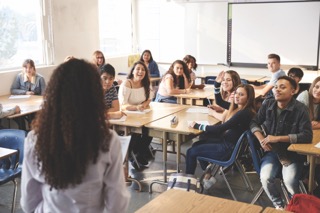 |
 |
 |
As teens transition from early to late adolescence, their interest in romantic relationships increases significantly.
15- to 17-year-olds are almost twice as likely as those ages 13 to 14 to have had some type of romantic relationship experience4
1 out of every 3 youth said they would like to know more about how to talk to a romantic partner regarding setting sexual boundaries5
The prevalence of early unhealthy romantic relationships is a strong predictor of negative individual health, such as2 :
- increased rates of depression
- lower self-esteem
- increase in likelihood of suicide attempts
Teens involved in healthy relationships experience greater overall emotional well-being. Teens who are better able to process their emotions are less likely to engage in risky sexual behaviors.6
Youth-focused Relationship Education (YRE) teaches evidence-based relationship skills that encourage teens to make smart relationship choices that lead to healthy relationships and overall well-being.
Relationships are a Normative Part of Adolescence
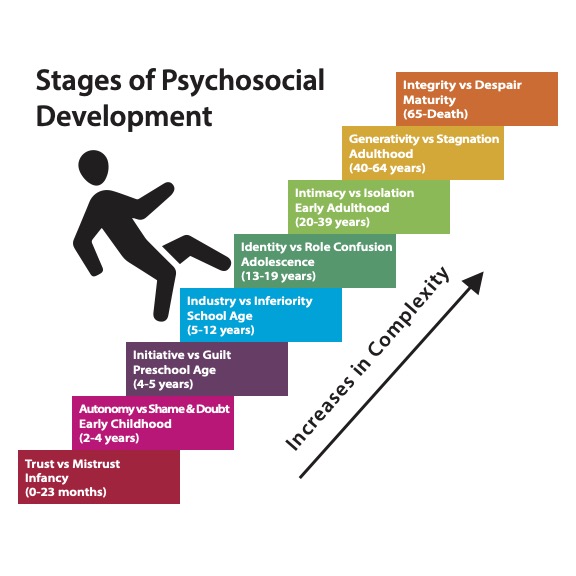
Adolescence is one of the most rapid phases of human development. It’s the time when teens learn to manage emotions and relationships, and acquire social skills and abilities that will be important for assuming adult roles. According to Erik Erikson’s stages of psychosocial development, adolescence is when 12-18 years olds begin to develop an identity.
Early romantic relationships provide important learning opportunities for developing one’s identity and learning interpersonal behaviors that tend to shape relational well-being in the future.7,8
Teens who successfully develop a strong identity are more likely to form stronger intimate relationships as young adults. In contrast, teens who struggle to find their identity are more likely to feel lonely and isolated. Erikson stated that developing a fully formed sense of self during this stage is essential to being able to form intimate relationships later on in life.


Adolescence is a time marked by teens’ increase in:
- the desire to be more autonomous,
- social immaturity,
- risk-taking, and
- spontaneity.
As a result, teens are more susceptible to making poor choices that could lead to sexual health risks.9
Thus, social skills learned from Youth-focused Relationship Education are extremely important. Teens who have positive social skills are more likely to:
- have higher levels of self-esteem;
- have success in academics; and
- have positive relationships with peers.10
Teens Engage in Sexual Behaviors
Teens are having sex too fast!
55% of adolescents become sexually active by 18 years of age.11
Approximately 1 in 5 15-year-olds and 2 and 3 18-year-olds have reported having sexual intercourse.12
Among sexually experienced teens, more than half (61%) reported they began having sexual intercourse within three months of the start of their romantic relationship.13
Despite drops in pregnancy numbers, teens are still getting pregnant
Although the teen pregnancy and birth rates in Georgia have decreased during the past two decades and are at historic lows, Georgia still ranks in the bottom 30% of all states.14
In 2018, there were 10,001 pregnancies among teens age 15 to 19 in Georgia, which translates to 28 out of every 1,000 Georgia teens. And, 20% of these pregnancies were repeat pregnancies.15


What is the pregnancy rate in your county?
As illustrated in the map, nearly two-thirds of all counties across Georgia had pregnancy rates about the state average.
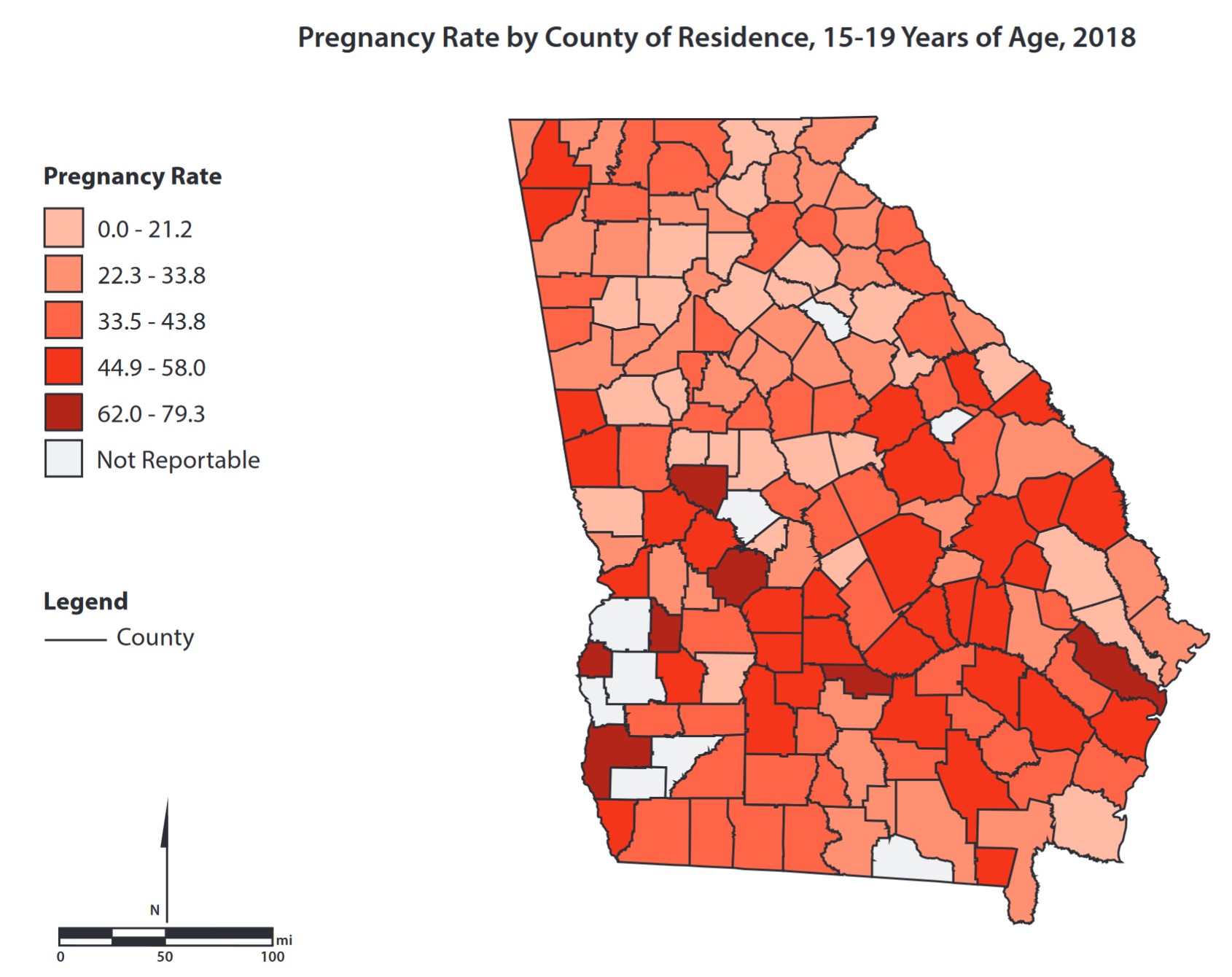
Source: https://oasis.state.ga.us/gis/TrendableMaps/...
In 2018, of the 10,001 pregnancies among teens age 15 to 19 in Georgia, 7,365 resulted in live births, 75% of which were to older teens age 18-19 years.15

Too many teens are acquiring Sexually Transmitted Infections (STIs).
In the United States, it is estimated that 38% of sexually active females will acquire an STI and young people age 15 to 24 years account for 50% of all new STIs.16
In Georgia, 58% of all STIs reported in 2018 were to young people age 15 to 24. Of the 52,172 STIs reported among 15-24 year olds, 42% were to teens age 15 to 19. As illustrated, STI rates are particularly higher in south Georgia.17
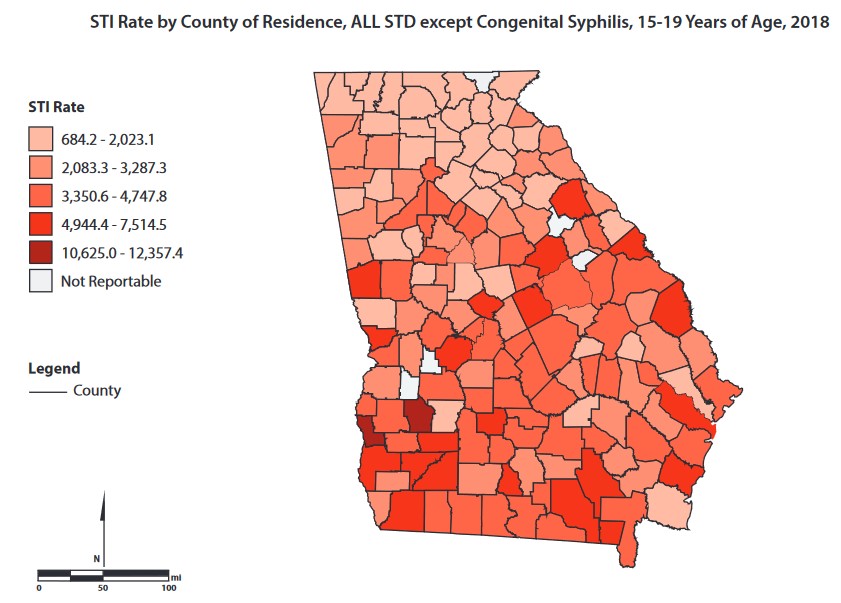
Source: https://oasis.state.ga.us/gis/T...
Note: All STI except Congenital Syphilis
Youth-focused Relationship Education covers:
- Sexual decision making
- Avoiding risky dating and early sexual behaviors
- Communicating with your partner to set clear boundaries and expectation
- Resisting sexual pressure
Youth-focused Relationship Education equips teens with the skills to resist sexual pressures and make better decisions about their relationships. These skills decrease the likelihood of engaging in risky sexual behaviors.
Teens Experience Dating Violence
Dating violence includes verbal, sexual, physical, or emotional abuse.
Nationally:
- One in three girls in the US is a victim of physical, emotional, or verbal abuse from a dating partner, a figure that far exceeds rates of other types of youth violence.18
- Nearly 1 in 11 female & approximately 1 in 15 male high school students report having experienced physical dating violence in the last year.19
- Teen victims of dating violence are 6 times more likely to get pregnant.20
- Dating violence among adolescents begins gradually, often starting with tensing and name calling. Unfortunately, adolescents tend to think of these behaviors as "normal" in a relationship.
According to the Partnership Against Domestic Violence (PADV), Georgia’s largest nonprofit working to end domestic violence, when the following signs happen suddenly or without any explanation, there might be cause for concern:21

- Sudden changes in clothing or make-up.
- Bruises, scratches, or other injuries.
- Failing grades, skipping class, or dropping out of school activities.
- Avoiding friends.
- Difficulty making decisions or always religion on the decisions of others.
- Sudden changes in mood or personality, becoming anxious or depressed, acting out, or being secretive.
- Changes in eating or sleeping habits, avoiding eye contact.
- Constantly thinking or worrying about their dating partner.
- Using alcohol or drugs.
- Emotional outbursts and "crying fits".
Teens who are victims of physical dating violence are more likely to:

- engage in risky sexual behaviors22
- engage in unhealthy diet behaviors22
- experience symptoms of depression and anxiety19,23
- abuse substances19,22
- consider and attempt suicide19,22
These increased risks lead to unhealthy relationship expectations where the cycle of violence is likely to continue.
Among adult victims of rape, physical violence, and/or stalking by an intimate partner, about 1 in 5 women and nearly 1 in 7 men first experienced some form of partner violence between 11 and 17 years of age.24
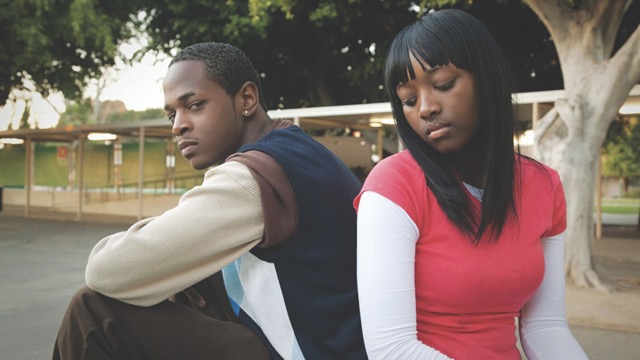
The incidence of dating violence among young adolescents is substantial and predicts future interpersonal risk for unhealthy and dangerous relationships.
Youth-focused Relationship Education helps teens:
- understand what healthy vs. unhealthy relationships are
- recognize the warning signs of abusive relationships
- develop skills to better manage conflict in safe ways
- increase self confidence levels to leave unhealthy relationships
Youth-focused Relationship Education can reduce the risk of teens experiencing dating violence and empower teens to seek help and leave unsafe and unhealthy relationships.
Unreliable Sources May Negatively Influence Teens

Adolescents may feel uncomfortable talking to their parents about sensitive subjects. As a result, teens tend to turn to the internet for dating tips and information related to sexual health, which often leads to teens making poor decisions.25
Much of the health information that teens encounter may be too complex, inaccurate, biased, or some combination of these.
What they see is what they learn
Research suggests that media, including films, television shows, and social media, can influence sexual behaviors and attitudes, as they showcase unrealistic expectations of what relationships look like.26
Many youths consume media that provide confusing or even harmful messages about intimate relationships.27 In turn, these will influence teens’ beliefs and attitudes about relationships.
Characters in media programming act as models for behavior, resulting in a process of observational learning which may result in the adolescent adopting the scripts, beliefs, and/or behaviors enacted by the media they are consuming.26
Observing behavior, good or bad, has a direct impact on teen attitudes and beliefs, and influences the behaviors that adolescents adopt.


Youth-focused Relationship Education that is research-based ensures that students are getting both helpful and accurate information.
The Impact of Unstable Role Models
The relationships that adolescents are exposed to while growing up shape their expectations for future relationships in both positive and negative ways.
- More than 1 in 5 children born to married parents and more than half of children born to cohabitating parents will see their parents breakup by age 9.28
- Almost 1 in 4 children live in a single parent household.29
- Compared to all other states in the U.S., Georgia has the 11th highest proportion of births to unmarried mothers at 45%.
Why does this matter?
More children today than ever before are growing up in unstable households, and as such, they are more likely to:2
- grow up experiencing economic hardship,
- witness domestic violence,
- see examples of unhealthy relationships, and
- repeat the cycle of instability in their future relationships.
Importantly, growing up in a married household does not guarantee that children and teens are exposed to healthy relationships. Married parents/caregivers who engage in frequent conflict and unhealthy behaviors also create an unstable and harmful environment that impacts children’s development, health, and future relationships.
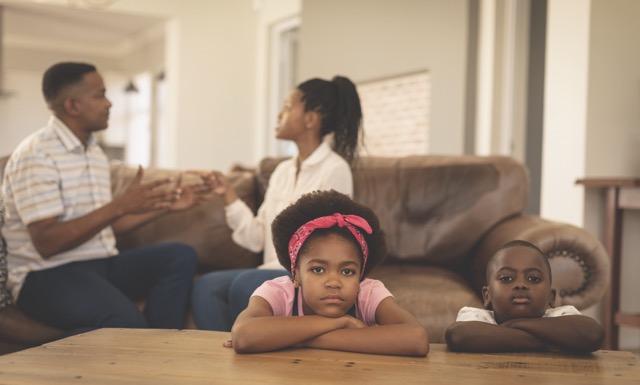

Teens aspire to marriage
More than 80% of adolescents expect to get married in their life, and of those who expect to get married, 90% of them expect to be married to the same person throughout their life.31
Youth-focused Relationship Education teaches teens the skills to make positive partner choices, and to build and sustain healthy marriages in the future.
Relationship Smarts Plus
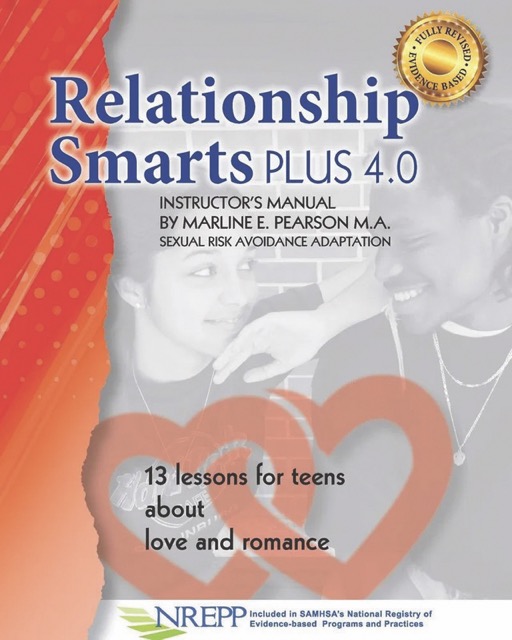
Among the Youth-focused Relationship Education curricula available, Relationship Smarts Plus (RS+)40 has been the curriculum of choice for UGA Extension when engaging youth through in-school and after-school programs across Georgia.33, 34
Distributed by The Dibble Institute, and included in the Substance Abuse and Mental Health Services Administration’s National Registry of Evidence-based Programs and Practices Legacy, RS+ is a widely-used relationship education curriculum for youth.35 The 13-lesson, activity-based curriculum, embodies an innovative and integrated approach designed to help youth better understand themselves, plan for the future, learn the characteristics of healthy relationships, and develop skills to form and maintain healthy relationships.36
The most current version of RS+ is a comprehensive healthy relationship skills and sexual risk avoidance program that addresses positive youth development, life skills, healthy relationships, communication/conflict management, dating violence, and sexual delay and risk avoidance. The curriculum:
- Builds assets and strengthens protective factors for teens as they develop healthy relationship skills.
- Appeals to teenagers’ aspirations, rather than merely emphasizing what they must avoid.
- Inspires youth to learn more about themselves, such as how their past has shaped the present, how to set goals, and how to identify steps needed to move towards those goals.
- Helps young people learn how to deal with pressure situations, examine friendships and clarify values, and further their own maturity.
- Guides them in developing the ability to recognize patterns of unhealthy and abusive relationships in terms of verbal or physical aggression, controlling behavior, lack of respect between partners, and ways to exit those relationships safely.
- Empowers teens with skills and insights for building healthy relationships, including communication and conflict management skills, as well as strategies to make healthy choices that will boost sexual delay, reduce risky behaviors, resist sexual coercion, and avoid dating violence.
RS+ LESSONS AND TOPICS
LESSON 1: Who am I and where am I going?
- Increase self-awareness
- Identify steps to strengthen and develop positive
personal qualities - Empower with decision making skills for pressure situations
- Assess positive and negative influences of current friendships
LESSON 2: Maturity issues and what I value
- Explore physical, mental, emotional, and social dimensions of maturity
- Discover areas of growth in one’s own development of maturity
- Reflect on values and determine which ones are important to teens
- Identify personality and character qualities teens find important in others
LESSON 3: Attractions and infatuation
- Improve awareness of the building blocks and characteristics of healthy relationships
- Gain knowledge about what infatuation is and how it affects decision making
- Increase understanding of how to wisely handle attraction to develop healthier relationships
LESSON 4: Principles of smart relationships
- Analyze smart and not-so-smart relationship attitudes, behaviors, and choices
- Apply 7 principles of smart relationships to assess one's relationship decisions
- Develop a realistic concept of love
LESSON 5: Is it a healthy relationship?
- Learn to use a three-question guide to decide if a relationship is healthy or unhealthy
- Understand what healthy and unhealthy relationships look like in the real world
- Develop language to assert one's opinions and discuss healthy relationships
- Generate a list of fun activities for relationships
LESSON 6: Breaking up and dating violence - parts 1 & 2
- Understand when it is time to end a relationship
- Identify better and worse ways to break-up with someone
- Learn how to deal with break-ups in a healthy way
- Raise awareness of early warning signs and behaviors of abuse and issues of consent and sexual assault
LESSON 7: Decide, don't slide!
- Learn the difference between a high-risk “sliding” vs. a low-risk “deciding” approach to developing relationships
- Gain insight about what’s important to learn about another person and oneself when developing a romantic relationship
- Build awareness of how past and present experiences and behaviors can create barriers to healthy relationships and reaching goals
- Become familiar with the Success Sequence for reducing one’s chances of living in poverty
LESSON 8: Communication and healthy relationships
- Understand how communication and conflict management skills impact relationships, regardless of the nature of the relationship
- Examine family of origin communication patterns and identify patterns youth want to work toward in their future
- Identify patterns that are most damaging to relationships
- Gain practice with the Time-Out Skill and the Speaker-Listener Technique
LESSON 9: Communication challenges and more skills
- Recognize that hidden issues often underlie ongoing arguments
- Demonstrate the use of a simple problem-solving model
- Create awareness of the need to nurture and care for relationships with regular appreciations
LESSON 10: Sexual decision-making
- Increase awareness of the benefits of making clear decisions about sex versus sliding
- Gain deeper understanding of dimensions of intimacy and how it develops
- Define sexual values and identify boundary lines and pacing of physical intimacy aligned with those values
- Consider risks and benefits of chosen boundary lines
LESSON 11: Pregnancy, STIs, and HIV
- Gain medically accurate information on sexual risk avoidance and reduction to dispel myths about pregnancy, STIs and HIV
- Understand how alcohol and drugs increase risks for sexual assault, pregnancy, STIs, and regrets
- Develop a personal plan for one’s sexual decisions
LESSON 12: Unplanned pregnancy through the eyes of a child
- Examine unplanned pregnancy through the eyes of a child
- Consider ways in which a healthy, stable relationship helps parents do the job of parenting
- Analyze the role of fathers in family formation and key barriers for father involvement
- Learn from former teen parents about decisions and steps young parents can make to ensure bright futures for themselves and their child
LESSON 13: Teens, technology, and social media
- Understand the impact of digital technology on relationships and social life, as well as emotional and mental health, including the risks of engaging in sexting, cyber-bullying, internet porn, etc.
- Examine what social and emotional skills are gained and lost through our highly wired, connected lives
YRE Meets Health Education Standards
In Georgia, health education aims to address the six priority adolescent risk behaviors identified by the U.S. Centers for Disease Control and Prevention (CDC): Alcohol and other Drug Use, Injury and Violence (including Suicide), Tobacco Use, Poor Nutrition, Inadequate Physical Activity, and Risky Sexual Behavior.
The Georgia Performance Standards for Health Education provide a framework for designing or selecting curricula, allocating instructional resources, and assessing student achievement and progress that are appropriate for state and local needs. Georgia Performance Standards for Health Education are based on the eight National Health Education Standards (NHES) that were developed to establish, promote, and support health-enhancing behaviors for students in all grade levels. These standards provide students, families and communities with concrete expectations for health education. By following these standards, it is hoped that Georgia teens will develop skills and knowledge to become healthy in all facets of their life and reduce their risk-taking behaviors.
National and Georgia Health Education Standards
- Core Concept. Students will comprehend concepts related to health promotion and disease prevention to enhance health.
- Analyzing Influences. Students will analyze the influence of family, peers, culture, media, technology, and other factors on health behaviors.
- Accessing Information. Students will demonstrate the ability to access valid information and products and services to enhance health.
- Interpersonal Communication. Students will demonstrate the ability to use interpersonal communication skills to enhance health and avoid or reduce health risks.
- Decision-Making. Students will demonstrate the ability to use decision-making skills to enhance health.
- Goal-Setting. Students will demonstrate the ability to use goal-setting skills to enhance health.
- Self-Management. Students will demonstrate the ability to practice health-enhancing behaviors and avoid or reduce health risks.
- Advocacy. Students will demonstrate the ability to advocate for personal, family, and community health.
How RS+ Lessons Align with Health Education Standards.
Relations Smarts Plus Lessons |
Health Education Standards | |||||||
|---|---|---|---|---|---|---|---|---|
| 1 | 2 | 3 | 4 | 5 | 6 | 7 | 8 | |
| LESSON 1: Who Am I and Where Am I Going? | X | X | X | X | X | X | X | |
|
LESSON 2: Maturity Issues and What I Value |
X | X | X | X | X | X | ||
| LESSON 3: Attraction and Infatuation | X | X | ||||||
| LESSON 4: Principles of Smart Relationships | X | X | X | X | ||||
| LESSON 5: Is It a Healthy Relationship? | X | X | X | X | X | X | ||
| LESSON 6: Breaking Up and Dating Violence | X | X | X | X | X | |||
| LESSON 7: Decide, Don't Slide! | X | X | X | X | ||||
| LESSON 8: Communication & Healthy Relationships | X | X | X | X | X | X | ||
| LESSON 9: Communication Challenges and More Skills | X | X | X | |||||
| LESSON 10: Sexual Decision Making | X | X | X | X | X | X | X | X |
| LESSON 11: Pregnancy, STIs, and HIV | X | X | X | X | X | |||
| LESSON 12: Unplanned Pregnancy Through the Eyes of a Child | X | X | X | |||||
| LESSON 13: Teens, Technology, and Social Media | X | X | X | |||||
For more information on the National Health Education Standards, visit: https://www.cdc.gov/healthyschools/sher/standards/index.htm
For more information about the Georgia Performance Standards for Health Education, visit: https://www.georgiastandards.org/Standards/Pages/BrowseStandards/HealthEd.aspx
National Report on School Health Policies and Practices
The CDC’s School Health Profiles provide biannual survey data used to assess school health policies and practices in middle and high schools throughout the United States. The School Health Profiles are used to monitor school health education and content, physical education and activity, bullying and sexual harassment policies and practices, tobacco use and nutrition policies, school-based health services, family and community involvement, and school health coordination.
The findings in the 2018 School Health Profile report show more schools across states are providing students health education on topics related to suicide and violence prevention. Also, more schools are creating safe and supportive environments for students, particularly students who identify as lesbian, gay, bisexual, transgender or questioning (LGBTQ), by putting policies and practices in place that protect them from a variety of health risks, and help students feel connected to the school. While the report shows progress in some school and health policies and practices, there are still areas that need improvement in order to better meet the needs of students.
The CDC identified the following 11 heath topics as needing improvement:
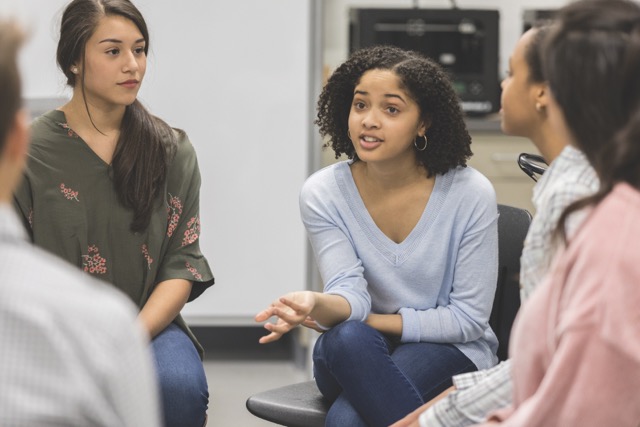
- How to create and sustain healthy and respectful relationships.
- Influences of family, peers, media, technology, and other factors on sexual
risk behavior. - Benefits of being sexually abstinent.
- Communication, conflict management, and negotiation skills.
- Goal-setting and decision-making skills.
- How HIV and other STDs are transmitted.
- Health consequences of HIV, other STDs, and pregnancy.
- Influencing and supporting others to avoid or reduce sexual risk behaviors.
- Importance of not rushing into sex.
- How to access valid and reliable information, products, and services related
to HIV, STDs, and pregnancy. - Preventive care that is necessary to maintain reproductive and sexual health.
Relations Smarts Plus Lessons |
Health Education Standards |
||||||||||
|---|---|---|---|---|---|---|---|---|---|---|---|
| 1 | 2 | 3 | 4 | 5 | 6 | 7 | 8 | 9 | 10 | 11 | |
| LESSON 1: Who Am I and Where Am I Going? |
X |
X | X | X | |||||||
|
LESSON 2: Maturity Issues and What I Value |
X | X | X | X | X | X | |||||
| LESSON 3: Attraction and Infatuation | X | X | |||||||||
| LESSON 4: Principles of Smart Relationships | X | X | X | X | X | ||||||
| LESSON 5: Is It a Healthy Relationship? | X | X | X | X | X | ||||||
| LESSON 6: Breaking Up and Dating Violence | X | ||||||||||
| LESSON 7: Decide, Don't Slide! | X | X | X | X | X | X | |||||
| LESSON 8: Communication & Healthy Relationships | X | X | X | X | X | ||||||
| LESSON 9: Communication Challenges and More Skills | X | X | X | X | X | ||||||
| LESSON 10: Sexual Decision Making | X | X | X | X | X | X | X | X | X | X | |
| LESSON 11: Pregnancy, STIs, and HIV | X | X | X | X | X | X | X | ||||
| LESSON 12: Unplanned Pregnancy Through the Eyes of a Child | X | X | X | ||||||||
| LESSON 13: Teens, Technology, and Social Media | X | X | X | X | |||||||
For more information about the CDC School Health Profiles, visit: https://www.cdc.gov/healthyyouth/data/profiles/index.htm
YRE Meets Sex Education Standards
Since 2018, school boards in Georgia have been required to “develop and implement an accurate, comprehensive health and physical education program.” According to the Georgia Comprehensive Health and Physical Education Program Plan, Sex Education/AIDS Education is expected to be part of each school’s comprehensive health program, and should include instruction on “handling of peer pressure, promotion of high self-esteem, local community values, and abstinence from sexual activity as an effective method of preventing acquired immune deficiency syndrome and the only sure method of preventing pregnancy and sexually transmitted diseases.” It is also expected that this instruction should emphasize abstaining until marriage and fidelity in marriage as an important personal goal. It is at the discretion of each local board of education to approve the sex/AIDS instructional materials for each age/grade level use. Still, there is little specific guidance provided by the state regarding the standards that should inform these decisions.
The National Sexuality Education Standards (NSES),37 originally published in 2012 and recently updated in 2020, were developed to address the inconsistent implementation of sexuality education nationwide and the limited time allocated to teaching the topic. The NSES is heavily based on the National Health Education Standards (NHES) as well as research on the characteristics of effective comprehensive sex education. The NSES outlines seven topics that are deemed as essential, minimum, core content and skills needed for sex education that is age-appropriate for students in grades K-12 to be effective. Each topic, includes a set of standards, or learning goals, associated with the NHES that represent the content and skills students should be able to demonstrate as a result of that instruction.

The Relationship Smarts Plus curriculum addresses six of the seven NSES topics, with the exception of “Anatomy and Physiology” which focuses on the functional knowledge students need to understand basic human functioning; this is typically covered in health science courses. The table below provides a description of the six topics, along with examples of the standards associated with each topic; see the full report for a more detailed breakdown of the standards by topic and grade level. The specific curriculum lessons that align with each topic are also listed.
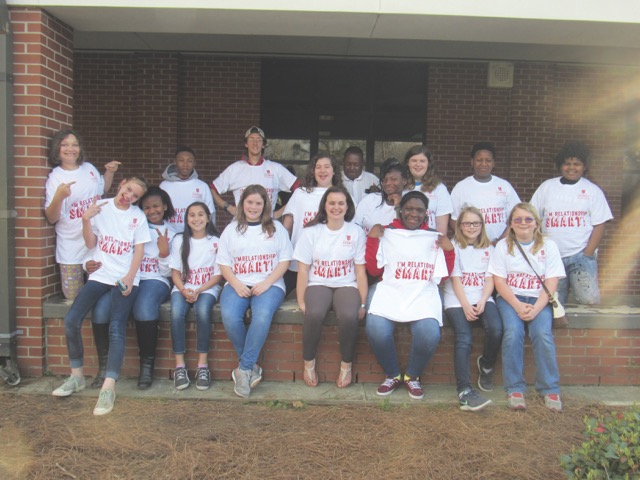
| National Sex Education Topics (RS+ Lesson Alignment) | Example Standards |
|---|---|
| Consent and Healthy Relationships. Offers guidance to successfully navigate changing relationships among family, peers, and partners. Special emphasis is given to personal boundaries, bodily autonomy, sexual agency and consent, and the increasing use and impact of technology within relationships. (RS+ Lessons 2-11 & 13) |
|
| Puberty and Adolescent Sexual Development. Addresses the pivotal milestones for every person that impact physical, social, and emotional development, and reinforces that sexual development is normal and healthy. (RS+ Lessons 1, 2, 10 & 11) |
|
|
Gender Identity and Expression. Addresses the fundamental aspects of people’s understanding of who they are as it relates to gender, gender identity, gender roles, and gender expression. (RS+ Lessons 1, 4, 6 & 7)
Sexual Orientation and Identity. Addresses the fundamental aspects of people’s understanding of who they are as it relates to sexual orientation and identity. (RS+ Lesson 1) |
|
| Sexual Health. Outlines the functional knowledge and essentials skills needed to understand STDs and HIV, including how they are prevented and transmitted, their signs and symptoms, and testing and treatment; how pregnancy happens, decision-making to avoid a pregnancy, and pregnancy prevention and options; and the personal and societal factors that influence sexual health decision-making and outcomes. (RS+ Lessons 3, 5, & 7-12) |
|
| Interpersonal Violence. Facilitates an understanding of interpersonal and sexual violence, including prevention, intervention, resources, and local services; emphasizes the need for a growing awareness, creation, and maintenance of safe school and community environments for all students. (RS+ Lessons 4-11 & 13) |
|

For more information about Georgia’s Comprehensive Health and Physical Education Program Plan, visit: https://www.gadoe.org/External-Affairs-and-Policy/State-Board-of-Education/SBOE%20Rules/160-4-2-.12.pdf
For more information about the National Sexuality Education Standards, visit: https://siecus.org/resources/national-sexuality-education-standards/
Characteristics of an Effective Health Education Curriculum
| Characteristics of Effective Curricula | How Relationship Smarts Meets the Standard |
|---|---|
| Is research-based and theory-driven | RS+ is grounded in research and includes instructional strategies and learning experiences built on theoretical approaches that influence health-related behaviors among youth. |
| Focus on specific behavioral outcomes | RS+ goes beyond the cognitive level and addresses health determinants, social factors, attitudes, values, norms, and skills that influence specific health-related behaviors. |
| Address individual values and group norms that support health-enhancing behaviors | Lessons 1 and 2 provide time for youth to reflect on their own values and who they are. Lessons 6, 7, 8, and 10 address group norms for middle and high school students and positive ways to handle situations that are common for their age in this day in time. |
| Focus on reinforcing protective factors and increasing personal perceptions of risk and harmfulness of engaging in specific health risk behaviors | Lessons 6, 7, 10, 11, 12, and 13 provide many examples of harmful behaviors that can lead to health risks whether it be violence, cyberbullying, pregnancy, STIs, or HIV. In each of these lessons, teens are encouraged and given an opportunity to reflect on their own protective factors and plan to stay safe. |
| Address social pressures and influences | Each lesson helps teens identify influences on their behavior and choices. For example, lesson 10 focuses on forming one’s own sexual decision-making process and lesson 13 describes social influences from social media and how to make safe decisions with technology. |
| Build personal and social competence as well as self-efficacy by addressing skills | All RS+ lessons work on personal development of the teen. For example, lessons 8 and 9 focus on building social skills and conflict resolution strategies. |
| Provide functional knowledge that is basic, accurate, and directly contributes to health-promoting decisions and behaviors | Each RS+ lesson includes the most recent statistics as well as resources for teens. Updates are regularly provided by The Dibble Institute. |
| Use strategies designed to personalize information and engage students | Each student completes workbook pages that coincide with every lesson and provide an opportunity for personal reflection. Also, each lesson has engaging activities and discussions. |
| Provide age- and developmentally-appropriate information, learning strategies, teaching methods and materials | RS+ incorporates technology through engaging videos as well as songs that are relevant to middle and high school students. Information about safety with technology as well as discovering identities is weaved in every lesson, which makes it appropriate for this age group. |
| Incorporate learning strategies, teaching methods and materials that are culturally inclusive | Multiple different perspectives are presented in each lesson and different cultures and backgrounds are represented in examples as well as videos throughout the lessons. |
| Provide adequate time for instruction and learning | Each RS+ lesson can range from 45 to 90 minutes in length. Some lessons can be edited to fit within the time range desired. |
| Provide opportunities to reinforce skills and positive health behaviors | Activities, discussions, reflections, and sometimes homework go along with each lesson. Students can complete this in their own workbook in order to look back on it at a later date. |
| Provide opportunities to make connections with other influential persons | Group activities provide time with peers to discuss topics and the teacher discusses topics open and honestly to provide a positive adult influence. |
| Include teacher information and plan for professional development and training to enhance effectiveness of instruction and student learning | The RS+ curriculum includes a guide to help teachers understand and implement the lessons. The Dibble Institute also offers resources on their website, and UGA Extension is also available to support GA schools by providing training and/or coming into schools to teach RS+. |
For more information regarding these standards, visit https://www.cdc.gov/healthyschools/sher/characteristics/index.htm
Relationship Education Works!
YRE increases knowledge and self-efficacy related to identifying healthy versus unhealthy relationship patterns and practices as well as using positive communication and conflict management skills to avoid risky dating and sexual behaviors. YRE can help correct unhealthy attitudes about dating relationships and improve essential social competencies that are needed for maintaining healthy romantic relationships.
A growing body of research confirm that YRE programs really work!38
Students who participate in YRE programs report:
|
A decrease in: |
An increase in: |
|---|---|
|
|
Why is YRE effective?
YRE programs that lead to positive outcomes for youth follow best-practices related to both curriculum content and the attributes and skills of the facilitator.43

Curriculum Content
- Has clear goals
- Is logically sequenced
- Is relevant for the target population
- Is evidence-based or evidence-informed
- Is delivered with high fidelity
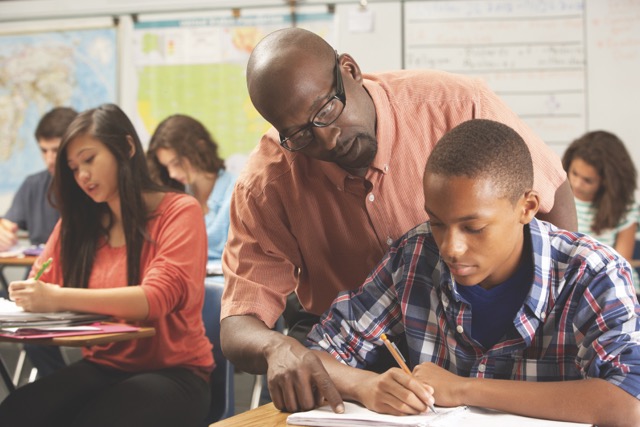
Facilitator Attributes/Skills
- Interacts with youth in a respectful manner
- Creates a welcoming environment for all youth
- Trained in the curriculum content
- Comfortable discussing sensitive content
- Able to establish professional boundaries with youth
Youth-focused Relationship Education increases the likelihood that adolescents will be prepared to make wise relationship decisions and to handle relationship challenges effectively.
UGA Extension is Here to Help!

The University of Georgia (UGA) Extension System works in partnership with school districts and community agencies all across Georgia to help our youth become relationship smart.
UGA Extension has a county delivery model where Family and Consumer Sciences (FACS) and/or 4-H County Extension Agents, who are public service faculty members, are the primary resource for local communities. Extension agents have access to a variety of subject matter state specialists at UGA who provide them training and support in delivering evidence-informed programs. In turn, county agents help keep state specialists apprised of the latest information and needs of their schools and communities.
Since 2008, FACS and 4-H agents across Georgia have delivered the RS+ curriculum to nearly 15,000 youth across 76 counties through in-school and after-school programs!
Where UGA Extension Has Helped Youth Become Relationship Smart To Date:
- 40 Counties where UGA Extension has delivered RS+ as part of Georgia’s Title V Sexual Risk Avoidance Education (SRAE) Grant Program, since 2017.
- 76 Counties where UGA Extension has delivered RS+, since 2008.
- 6,753 Youth reached through SRAE program, since 2017.
- 14,814 Youth completed RS+ program, since 2008.
- 80% Found the program helpful.
- 73% Felt better about themselves.
- 78% Felt more confident in forming healthy relationships and applying the interpersonal skills learned.
- 77% Reported they will use the skills learned.
Watch this video to see how UGA Extension is impacting youth in Washington County. https://youtu.be/v_RPn41ZwUs
Sources
- Wood, R. G., Avellar, S., & Goesling, B. (2008). Pathways to adulthood and marriage: Teenagers’ attitudes, expectations, and relationship patterns. Mathematica Policy Research. https://aspe.hhs.gov/report/pathways-adulthood-and-marriage-teenagers%E2%80%99-attitudes-expectations-and-relationship-patterns-aspe-research-brief
- Simpson, D. M., Leonhardt, N. D., & Hawkins, A. J. (2018). Learning about love: A meta-analytic study of individually-oriented relationship education programs for adolescents and emerging adults. Journal of Youth and Adolescence, 47(3), 477-489. https://doi.org/10.1007/s10964-017-0725-1
- Furman, W., & Shaffer, L. (2003). The role of romantic relationships in adolescent development. In P. Florsheim (Ed.), Adolescent romantic relations and sexual behavior: Theory, research, and practical implications (pp. 3–22). Erlbaum.
- Lenhart, A., Smith, A., & Anderson, M. (2015, October 1). Teens, technology and romantic relationships. Pew Research Center.
- National Coalition for Sexual Health. (2018). (rep.). The sexual health of youth in the United States: An audience profile. https://nationalcoalitionforsexualhealth.org/data-research/audience-profiles/document/AdolescentBackgrounder-final.pdf
- Salerno, A., Tosto, M., & Antony, S. D. (2015). Adolescent sexual and emotional development: The role of romantic relationships. Procedia-Social and Behavioral Sciences, 174, 932-938. https://doi.org/10.1016/j.sbspro.2015.01.714
- Gómez-López, M., Viejo, C., & Ortega-Ruiz, R. (2019). Well-being and romantic relationships: A systematic review in adolescence and emerging adulthood. International Journal of Environmental Research and Public Health, 16(13), 2415. https://doi.org/10.3390/ijerph16132415
- Suleiman, A. B., & Harden, K. P. (2016). The importance of sexual and romantic development in understanding the developmental neuroscience of adolescence. Developmental Cognitive Neuroscience, 17, 145–147. https://doi.org/10.1016/j.dcn.2015.12.007
- Arain, M., Haque, M., Johal, L., Mathur, P., Nel, W., Rais, A., Sandhu, R., & Sharma, S. (2013). Maturation of the adolescent brain. Neuropsychiatric Disease and Treatment, 9, 449–461. https://doi.org/10.2147/NDT.S39776
- Scott, M. E., Moore, K. A., Hawkins, A. J., Malm, K., & Beltz, M. (2012). Putting youth relationship education on the child welfare agenda: Findings from a research and evaluation review. Child Trends. https://www.childtrends.org/publications/putting-youth-relationship-education-on-the-child-welfare-agenda-findings-from-a-research-and-evaluation-review-full-report
- Abma, J. C., & Martinez, G. M. (2017). Sexual activity and contraceptive use among teenagers in the United States, 2011- 2015. National health statistics reports, (104), 1–23. https://pubmed.ncbi.nlm.nih.gov/28696201/
- Boyer, J. (2018). New name, same harm: Rebranding of federal abstinence-only programs. Guttmacher Policy Review, 21, 11–16. https://www.guttmacher.org/gpr/2018/02/new-name-same-harm-rebranding-federal-abstinence-only-programs
- Ryan, S., Manlove, J., & Franzetta, K. (2003). First time: Characteristics of teens’ first sexual relationships. Child Trends Research Brief. https://www.childtrends.org/publications/the-first-time-characteristics-of-teens-first-sexual-relationships
- Power to Decide. (2020, July 9). Georgia data. https://powertodecide.org/what-we-do/information/national-state-data/georgia
- Georgia Department of Public Health. (n.d.). Number of Pregnancies, 10-19 Years of Age, Georgia, 2018. OASIS Trending Tool. Retrieved July 8, 2020, from https://oasis.state.ga.us/
- Wildsmith, E., Barry, M., Vaughn, B., & Manlove, J. (2013, October). Adolescent health highlight. Child Trends. https://www.childtrends.org/wp-content/uploads/2013/10/2013-07STDs.pdf
- Georgia Department of Public Health. (n.d.). Number of STD cases, all STD except congenital syphilis, 10-19 years of age, Georgia, 2018. OASIS Trending Tool. Retrieved July 8, 2020, from https://oasis.state.ga.us/
- Davis, A. (2008). Interpersonal and physical dating violence among teens. The National Council on Crime and Delinquency Focus. http://www.nccd-crc.org/nccd/pubs/2008_focus_teen_dating_violence.pdf
- Centers for Disease Control and Prevention. (2020, July 9). Preventing teen dating violence. https://www.cdc.gov/violenceprevention/intimatepartnerviolence/teendatingviolence/fastfact.html
- Decker, M., Silverman, J., & Raj, A. (2005). Dating violence and sexually transmitted disease/HIV testing and diagnosis among adolescent females. Pediatrics, 116, 272-276. https://doi.org/10.1542/peds.2005-0194
- Partnership Against Domestic Violence. (2020, July 9). Teen dating violence info for adults. https://padv.org/dating-violence/
- Silverman, J. G., Raj, A., Mucci, L. A., & Hathaway, J. E. (2001). Dating violence against adolescent girls and associated substance use, unhealthy weight control, sexual risk behavior, pregnancy and suicidality. Journal of the American Medical Association, 286(5), 572–579. https://doi.org/10.1001/jama.286.5.572
- Brown, A., Cosgrave, E., Killacey, E., Purcell, R., Buckby, J., & Yung, A.R. (2009). The longitudinal association of adolescent dating violence with psychiatric disorders and functioning. Journal of Interpersonal Violence, 24(12), 1964-1979. https://doi.org/10.1177/0886260508327700
- Centers for Disease Control and Prevention. (2020, July 9). Dating matters. https://www.cdc.gov/intimate-partner-violence/php/datingmatters/
- Guttmacher Institute. (2017, December). American adolescents’ sources of sexual health information. https://www.guttmacher.org/fact-sheet/facts-american-teens-sources-information-about-sex
- Bleakley, A., Ellithorpe, M. E., Hennessy, M., Khurana, A., Jamieson, P., & Weitz, I. (2017). Alcohol, sex, and screens: Modeling media influence on adolescent alcohol and sex co-occurrence. The Journal of Sex Research, 54(8), 1026-1037. https://doi.org/10.1080/00224499.2017.1279585
- Ward, M. L. (2016). Media and sexualization: State of empirical research, 1995–2015. The Journal of Sex Research, 53, 560-577. https://doi.org/10.1080/00224499.2016.1142496
- Livingston, G. (2018, April 27). About one-third of U.S. children are living with an unmarried parent. https://www.pewresearch.org/fact-tank/2018/04/27/about-one-third-of-u-s-children-are-living-with-an-unmarried-parent/
- Kramer, S. (2019, December 12). U.S. has world’s highest rate of children living in single-parent households. Pew Research Center. https://www.pewresearch.org/fact-tank/2019/12/12/u-s-children-more-likely-than-children-in-other-countries-to-live-with-just-one-parent/
- Centers for Disease Control and Prevention. (2020, April 21). National Center for Health Statistics: Georgia. https://www.cdc.gov/nchs/pressroom/states/georgia/ga.htm
- Wood, R. G., Moore, Q., Clarkwest, A., & Killewald, A. (2014). The long-term effects of building strong families: A program for unmarried parents. Journal of Marriage and Family, 76(2), 446-463. https://doi.org/10.1111/jomf.12094
- Pearson, M. (2007). LoveU2: Relationship Smarts PLUS. The Dibble Institute for Marriage Education. https://www.dibbleinstitute.org/our-programs/relationship-smarts-plus-sra/#1567669604788-e0bad883-2b31f032-e279
- Futris, T. G., Sutton, T. E., & Duncan, J. C. (2017). Factors associated with romantic relationship self-efficacy following youth-focused relationship education. Family Relations, 66(5), 777-793. https://doi.org/10.1111/fare.12288
- Futris, T. G., Sutton, T. E., & Richardson, E. W. (2013). An evaluation of the relationship smarts plus program on adolescents in Georgia. Journal of Human Sciences and Extension, 1(2), 1–15. https://doi.org/10.54718/BARJ9780
- Baumgartner, S. & Zaveri, H. (2018). Implementation of Two Versions of Relationship Smarts Plus in Georgia (OPRE Report # 2018-121). Office of Planning, Research and Evaluation, Administration for Children and Families, U.S. Department of Health and Human Services.
- Pearson, M., & Reed, K. (2015). Youth-focused relationship education: Relationship Smarts PLUS and Love Notes. In J. Ponzetti (Ed.), Evidence-based approaches to relationship and marriage education. Routledge.
- Future of Sex Education Initiative. (2020). National Sex Education Standards: Core Content and Skills, K-12 (2nd ed.). https://advocatesforyouth.org/media/future-of-sex-education-national-sex-education-standards-second-edition/
- McElwain, A., McGill, J., & Savasuk-Luxton, R. (2017). Youth relationship education: A meta-analysis. Children and Youth Services Review, 82, 499-507. https://doi.org/10.1016/j.childyouth.2017.09.036
- Rice, T. M., McGill, J., & Adler-Baeder, F. (2017). Relationship education for youth in high school: Preliminary evidence from a non-controlled study on dating behavior and parent–adolescent relationships. Child & Youth Care Forum, 46, 51–68. https://doi.org/10.1007/s10566-016-9368-8
- Antle, B. F., Sullivan, D. J., Dryden, A., Karam, E. A., & Barbee, A. P. (2011). Healthy relationship education for dating violence prevention among high-risk youth. Children and Youth Services Review, 33, 173-179. https://doi.org/10.1016/j.childyouth.2010.08.031
- Schramm, D. G., & Gomez-Scott, J. (2012). Merging relationship education and child abuse prevention knowledge: An evaluation of effectiveness with adolescents. Marriage & Family Review, 48, 792–808. https://doi.org/10.1080/01494929.2012.714722
- Gardner, S. P., Giese, K., & Parrott, S. M. (2004). Evaluation of the connections: Relationships and marriage curriculum. Family Relations, 53(5), 521-527. https://doi.org/10.1111/j.0197-6664.2004.00061.x
- Scott, M. E., Karberg, E., Huz, I., & Oster, M. (2017). Healthy marriage and relationship education programs for youth: An in-depth study of federally funded programs (OPRE Report #2017-74). Office of Planning, Research and Evaluation, Administration for Children and Families, U.S. Department of Health and Human Services.
Status and Revision History
Published on Oct 22, 2020
Published with Full Review on Oct 14, 2024


























































